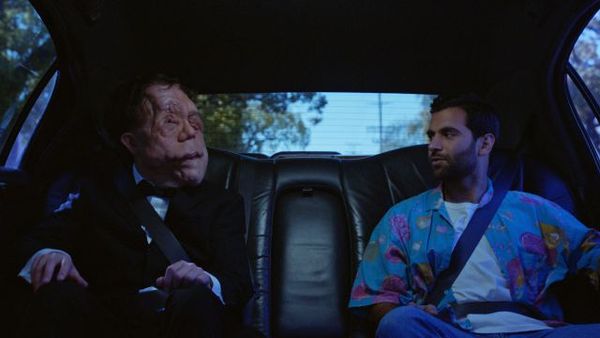Eye For Film >> Movies >> DRIB (2017) Film Review
DRIB
Reviewed by: Jennie Kermode

Which is worst: the pain of being hit with a baseball bat, or the pain of not being famous?
That might depend. If it's your friend wielding the baseball bat and the blood and screaming are staged, enduring a beating for the sake of stardom comes to seem much more reasonable. It's the sort of thing you might imagine being staged by a big company interested in building up an edgy brand; but, interestingly, it seems it's something that at least one such company didn't imagine a member of the public might do. And that's why said company - its name as yet a secret - hired performance artist Amir Asgharnejad to front such a campaign, which it intended to 'leak' as an abandoned campaign in order to gain publicity from the ensuing scandal, before abandoning it for real and sending Asgharnejad home to Norway with a story never to be revealed on pain of lawsuit.

Of course, Asgharnejad never had any intention of staying silent. He immediately hooked up with documentarian Kristoffer Borgli and the two flew to LA to recreate events in docudrama style. This led to the creation of fictitious energy drink DRIB, with its own par for the course branding: sweatshirts, baseball caps, short videos of men pouring it over their faces instead of into their mouths. This film is essentially a mockumentary closely based on real events, but there's extensive breaking of the fourth wall. It's in appropriate company at Fantasia
Borgli's observational approach to filmmaking and the bright, flat lighting in most of the interiors lends a strong documentary tone, and a cameo by Adam Pearson, who is in town to make a charity advert and speaks openly as himself, adds depth to the project, reminding viewers that organisations of all kinds rely on branding.
What is branding about? They key tenet of the industry is that one is never selling a product, one is selling a lifestyle. Products come and go and may not be seen as having much value in themselves, but consumers are willing to spend a great deal for something that by turn associates them with a certain set of aesthetics and values. The shock tactics of using supposedly real life violence in the service of this are not new - though as an attempt to film an advert with an actor who has not been fully informed about the project shows, Fight Club was right: normal people will do pretty much anything to avoid a fight.
There's nothing particularly cinematic about Borgli's work and in many ways it might be better suited to television, where the intercutting of adverts would suit its satirical purposes well. It's also overlong, thanks in part to Borgli's decision to include footage of Asgharnejad exploring the supposed Hollywood lifestyle when he ought to be working, something which it seems may have been a contributing factor in his real campaign being dropped. This is making a point, but it's also dragging things out in a way that detracts from the comedy, and the film is never really as funny as it ought to be. Too many of its observations have been made too often before.
The better scenes here are those in which Asgharnejad himself gets out of his depth, torn between fessing up about the fakery behind his online stunts and keeping his business options open. It can be tough to be cast as a bad guy. Ultimately, DRIB is a victim of its own success. Its exploration of the tension between the real and the fake is timely and important, but behind that is something more dangerous, and perhaps the leading item on the fake news agenda. When people no longer feel that they can effectively assess the value of information, they lose interest in it altogether.
Reviewed on: 23 Jul 2017















